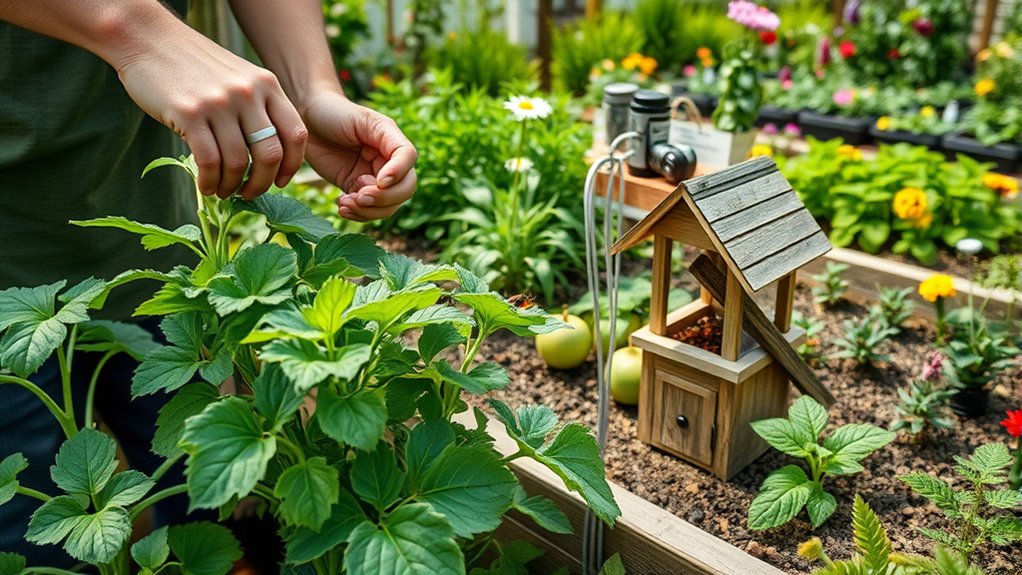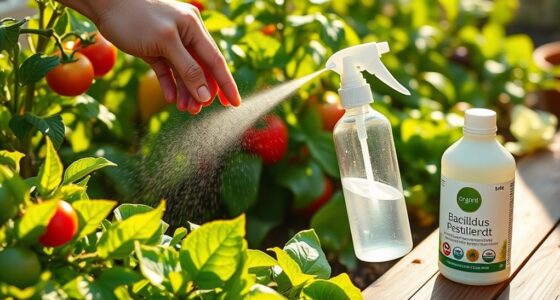Integrated Pest Management (IPM) is a sustainable way for gardeners to control pests by combining natural methods, monitoring, and targeted strategies, reducing reliance on chemical pesticides. It encourages you to understand your garden’s ecosystem, use beneficial insects, and regularly check plants for early signs of pests. IPM promotes safety for both your plants and the environment. If you keep exploring, you’ll discover how to implement these practices effectively for a healthier garden.
Key Takeaways
- IPM combines environmental, biological, and cultural strategies to manage pests sustainably in gardens.
- It emphasizes early detection and regular monitoring to minimize pesticide use.
- Biological controls involve encouraging natural predators like ladybugs and parasitoid wasps.
- Natural pest control methods avoid broad-spectrum chemicals, promoting beneficial insects and ecological balance.
- The goal of IPM is to protect plants and the environment while effectively managing pest populations.

Ever wondered how to keep pests under control without harming your garden? That’s where integrated pest management (IPM) comes into play. IPM is a smart, environmentally friendly approach that combines various strategies to manage pests effectively. Instead of relying solely on chemical pesticides, you focus on understanding your garden’s unique ecosystem and applying targeted methods. One of the core concepts in IPM is using biological controls, which involve introducing or encouraging natural predators of pests. For example, releasing ladybugs to control aphids or using parasitoid wasps to manage caterpillars can markedly reduce pest populations without risking harm to beneficial insects or your plants. Biological controls are sustainable and help maintain the balance in your garden’s ecosystem.
To implement IPM successfully, you’ll need to adopt monitoring techniques that help you detect pest problems early. Regular inspections are essential—walk through your garden at least once a week, looking closely at leaves, stems, and soil for signs of pests or damage. Using tools like sticky traps or pheromone traps can also alert you to the presence of specific pests before they become a serious threat. Monitoring techniques allow you to gather data about pest levels and plant health, so you can make informed decisions about when and how to intervene. This proactive approach minimizes unnecessary pesticide use and targets pests only when populations reach a threshold that could cause considerable damage. Additionally, understanding the garden’s ecosystem helps you identify natural pest control opportunities and maintain ecological balance.
Combining biological controls with diligent monitoring helps you avoid broad-spectrum chemical applications, which can harm beneficial insects and disrupt your garden’s natural balance. Instead, you’ll focus on integrated tactics, like encouraging beneficial insects through planting nectar-rich flowers or creating habitats that support natural predators. When pest levels do rise beyond acceptable limits, you can respond with targeted interventions, such as organic insecticidal soaps or horticultural oils, which are safer for your plants, pollinators, and the environment.
Ultimately, IPM empowers you to take control of pest issues in a way that’s safe, effective, and sustainable. By understanding and applying biological controls alongside vigilant monitoring techniques, you promote a healthy garden where pests are managed without resorting to harsh chemicals. This balanced approach not only protects your plants but also preserves the beneficial insects and overall ecological health of your garden. With patience and practice, you’ll develop a keen eye for early pest detection and an arsenal of natural strategies that keep your garden thriving.
Frequently Asked Questions
How Does IPM Differ From Traditional Pest Control Methods?
You’ll find that IPM differs from traditional pest control because you focus on pest monitoring and using targeted methods rather than relying solely on chemicals. Traditional approaches often depend on chemical dependence, which can harm your garden and environment. IPM emphasizes understanding pest behavior, using biological controls, and applying chemicals only when necessary, making it a more sustainable and effective way to protect your plants without overusing pesticides.
Are There Any Environmental Risks Associated With IPM?
You might worry about environmental impact, but IPM minimizes risks by focusing on pesticide safety and reducing chemical use. It targets pests precisely, avoiding unnecessary harm to non-target species and ecosystems. While no method is entirely risk-free, IPM’s integrated approach considerably lowers potential environmental hazards compared to conventional pesticide-heavy practices. This careful balance helps protect your garden and the broader environment, making it a safer, more sustainable choice.
Can IPM Be Used for Organic Gardening?
Yes, you can use IPM in organic gardening because it emphasizes organic compatibility and pest suppression through natural methods. You’ll rely on cultural controls, biological agents, and organic-approved treatments to manage pests effectively. This approach minimizes chemical use, aligning with organic principles. By monitoring pests and applying targeted, eco-friendly solutions, you promote a healthy garden environment while controlling pest populations sustainably.
What Are Common Pests Targeted by IPM?
Pest problems persist, so you need precise pest identification to prevent crop damage. Common pests include aphids, beetles, caterpillars, and snails, which target vegetables, fruits, and ornamentals. By recognizing these pests early, you can implement targeted, eco-friendly strategies. IPM helps you control pests efficiently, minimizing harm to beneficial insects and your plants, ultimately protecting your garden’s health and productivity.
How Long Does It Typically Take to See Results With IPM?
You can typically expect to see results with IPM within a few weeks, but timing expectations depend on the pests and methods used. By regularly practicing observation techniques, you’ll notice changes in pest activity and plant health. Consistency is key, so stay vigilant and modify your approach as needed. Patience and careful monitoring help guarantee effective pest control, leading to healthier, pest-resistant plants over time.
Conclusion
By embracing integrated pest management, you’re releasing the ultimate weapon against pests—more powerful than any chemical bomb! It’s your secret weapon to protect your garden’s beauty and health, turning you into a legendary gardener who conquers pests without harmful toxins. Imagine a thriving, pest-free paradise, all thanks to your smart, sustainable choices. With IPM, you hold the key to a garden that’s unstoppable, vibrant, and forever flourishing—more alive than you ever thought possible!









